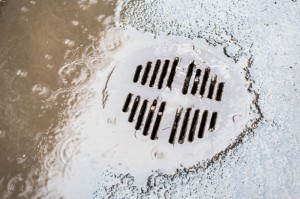
A key thing to remember when dealing with a sewer backup or flood is that you should never assume it has stopped until the water level starts to go down. Sewer backups can be from flooding, blockages, ruptures, or leaks, and all these are not causes exclusive to each other.
Sewage is, for lack of a better term, filthy. It contains bacteria, fungi, parasites, and viruses that may not even require direct contact with the water to infect you. The most common modes of infection are via hand-to-mouth, through cuts or open wounds, when wiping your face or eyes, or through inhaling water droplets or sometimes water vapour. Be very careful of how you may be exposing yourself to infection when navigating around (or through) an area flooded by a sewer backup.
Protective Measures
In order to minimize the risk of infection from contaminated water, keep the following preventative steps in mind:
- Stop flushing toilets and shut off any running water that could be flowing to the drainage system. This will prevent your individual home from contributing to the problem.
- Cut power to the affected area. Any plugs, wires, or sockets that could be in reach of the floodwater will only present a hazard to yourself and any clean-up workers.
- Do not go near the contaminated water without protective gear. This means rubber boots, gloves, goggles, long sleeves, and maybe even a mask to cover your mouth and nose.
- Wash your hands with soap and warm water after leaving the contaminated area or handling items from it.
- If you have any open wounds, keep them as clean as possible by using antibiotic ointments or soaps.
- Seek medical attention if you begin to feel ill.
- Wash any clothing you wear during the clean-up in a separate load from uncontaminated items. Obviously, since you have just experienced a flood, you should have your wastewater system checked before doing this step.
Decontamination
In addition to draining the affected area and preventing or mitigating water damage, sewage backups also call for decontamination steps to prevent salvaged objects from spreading disease.
- Drywall, insulation, carpeting, mattresses, padded rugs, stuffed toys, pillows, foam-rubber objects, and most paper products cannot be effectively washed or disinfected so you will have to throw them out.
- Scrub down hard surface. Ideally, use no more than half a cup of bleach for every gallon of water.
- If you use ammonia, be VERY careful not to mix it with bleach. If you combine the two, you will end up with chlorine gas and things will end badly for all parties involved.
- Be sure to have your septic system checked for any damage or leaks. It would suck to have gone through all this trouble only to have it flooded again.
- Do not bring contaminated items into uncontaminated areas of the house if possible. Should leaving the contaminated items outside be impractical, you can use a room with a concrete or tiled floor to minimize the risk of spreading contaminants.
- Open any windows or curtains and let the sunlight in if you can. Sunlight can slow down bacterial growth and provide disinfectant help.
- Specialty drying equipment (installed in accordance with IICRC ASD standards), air conditioning units and heaters can be employed to help speed up the drying process.
Get Quick and Professional Help
Managing an effective sewage clean-up is a challenging task that can put you at risk of serious illness if completed incorrectly. Flood Services Canada Inc. stands ready to provide quick-response clean-up services across the GTA and will use the best techniques, personnel, and technology to ensure your home is clean, safe, and dry as soon as possible. Contact us at (416) 302-2107 to learn more about how to protect your property. For emergencies, you can call us at (416) 999-3930 to get our rapid response teams deployed to your area within 45 minutes.
